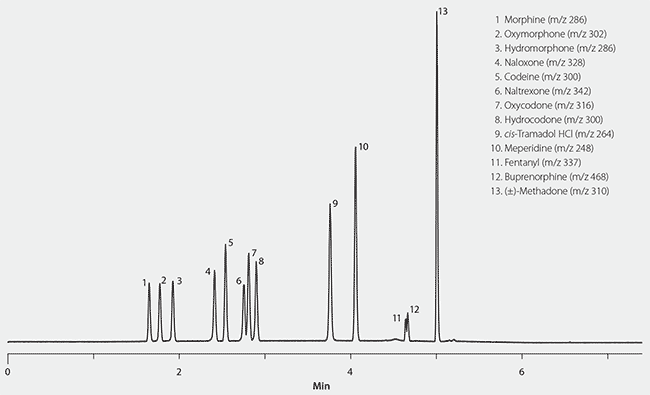Benefits of Ascentis Express Phenyl-Hexyl Over Biphenyl for the Separation of Pain Management Opiates
Pain management drugs are among the most prescribed medications, and they are also the most abused class of prescription drugs1-2. Therefore, many states have enacted laws governing the prescription of pain management drugs. Patients enrolled in pain management programs need to be monitored for compliance, which means appropriate use of prescribed drugs and abstinence from non-prescribed drugs. In a clinical setting, the presence of an illicit or non-prescribed drug does not necessarily negate the legitimacy of the patient’s pain complaints, but it may suggest a concurrent disorder such as drug abuse or addiction.
High performance liquid chromatography tandem mass spectrometry (HPLC-MS/MS) offers high resolving power, high selectivity, and wide dynamic range, all of which enable simultaneous quantification of a broad spectrum of drugs present in biological matrices3. In clinical laboratories, HPLC-MS/MS can be used as a confirmation method in conjunction with a prior immunoassaybased screening method, or it can be used as a stand-alone screening method offering quantitative results with high confidence.
Phenyl-hexyl Column Chemistry Compared to C18 and Biphenyl
Phenyl-based HPLC phases have proven particularly suited for the separation of pain management compounds. A good example is the Ascentis® Express Phenyl-Hexyl which is based on the covalent modification of high-purity, spherical, Fused-Core® silica particles with alkyl-aromatic functional groups. The distinct selectivity of the phenyl-hexyl phase comes from analytes interacting with the aromatic ring and its delocalized electrons. In Figure 1, the phenyl-hexyl phase is shown separating the set of pain management compounds listed Table 1.

Figure 1. LC/MS Analysis of Pain Management Opioids on Ascentis Express Phenyl-Hexyl
Conditions
column: Ascentis Express Phenyl-Hexyl, 10 cm × 2.1 mm, 2.7 µm particles (Product No. 53336-U); mobile phase: [A] water with 0.1% formic acid; [B] methanol with 0.1% formic acid; gradient: 10 to 45% B in 3 min; to 100% B in 2 min; held for 2.4 min; flow rate: 0.3 mL/min; pressure: 6940 psi (478 bar); column temp.: 30 °C; detector: MS, ESI(+), SIR; injection: 2 µL
Phenyl-hexyl is complementary (orthogonal) to conventional reversed-phase C18 phases because of its aromatic character, and to biphenyl phases because of its aliphatic nature. Although both biphenyl and phenyl-hexyl phases can resolve the pain management compounds, the Ascentis Express Phenyl-Hexyl exhibits substantially less silanol-derived ion exchange activity. To measure this, both phases were run under conditions designed to test for silanol activity4. The longer retention and poor peak shape of amitriptyline in the resulting chromatograms in Figure 2 indicate the strong presence of silanol activity on the competitive brand biphenyl phase that is not seen on Ascentis Express Phenyl-Hexyl. Although one could explain the excessive silanol activity to poor bonded phase coverage on the biphenyl column, it does point to the need to look beyond the bonded phase molecule alone when developing, optimizing, or troubleshooting a method, including when the objective is to resolve pain management compounds.

Figure 2. Probes for Silanol Activity on Phenyl-Hexyl and Biphenyl Phases. Retention of amitriptyline shows peak tailing due to higher silanol activity on the competitive brand biphenyl that is not seen on Ascentis Express Phenyl-Hexyl.
Conditions
columns: 1) Ascentis Express Phenyl-Hexyl, 10 cm × 2.1 mm I.D., 2.7 µm particles (Product No. 53336-U);
2) biphenyl column of the same dimensions; mobile phase: [A] 20 mM potassium phosphate dibasic, pH 7 (adjusted with phosphoric acid); [B] methanol; (20:80, A:B); flow rate: 0.3 mL/min; column temp.: 35 °C; detector.: UV, 250 nm; injection: 1 µL; sample: uracil (5 µg/mL), toluene, ethylbenzene (each 500 µg/mL), quinizarin, amitriptyline (each 50 µg/mL) in 25:75, water:methanol
Conclusion
Ascentis Express Phenyl-Hexyl phase exhibits perfect balance of hydrophobicity, shape selectivity, and bonding density, while delivering excellent peak shape for polar analytes. While a biphenyl phase will also provide resolution, there are subtle differences that can cause poor peak shape due to its higher silanol activity. The combination of unique bonded phase chemistry and Fused-Core silica particles results in Ascentis Express Phenyl-Hexyl showing:
- High aromatic selectivity and high hydrophobic retention
- Excellent peak shape for silanol-sensitive analytes
- High efficiency from the reduced C-term (diffusion) of the Fused-Core particles
- Rugged, reliable, long-term operation, even with biological samples
These benefits make Ascentis Express Phenyl-Hexyl an ideal choice for testing labs running pain management panels.
Para seguir leyendo, inicie sesión o cree una cuenta.
¿No tiene una cuenta?